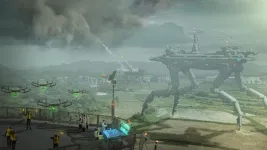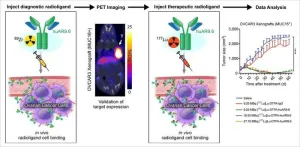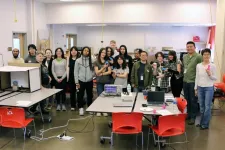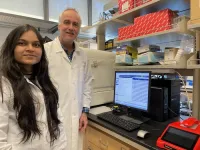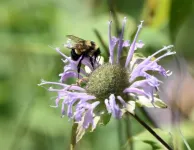(Press-News.org) Human activity is changing the way water flows between the Earth and atmosphere in complex ways and with likely long-lasting consequences that are hard to picture.
Land use change is altering where clouds form and how precipitation is distributed. Meanwhile, weather modification activities like cloud seeding are shifting how nations plan for water use in the face of climate change. These and other changes to the planet’s atmospheric water cycle were once hard to imagine but are increasingly part of modern water management on the planet.
Colorado State University Assistant Professor Patrick Keys is an expert in climate and societal change. He has been studying these types of issues for years and realized there was a potential gap when it came to understanding – not only in the public but among the water research community – the lasting implications of these changes.
To better grasp how those kinds of activities could shape the world, he enlisted water scientists from around the globe to write story-based scenarios about the possible futures humanity is facing but perhaps can’t quite comprehend yet. The results were recently published in Global Sustainability as part of a creative pathway to understand atmospheric water research with an eye towards the potential economic and policy issues that may be just beyond the horizon.
The work features striking artist-made images that pair with traditional science fiction narratives as well as alternative story forms like first-person journal entries. Keys said the package offers a wide path – grounded in science – to build a shared understanding of future water management activities and problems.
“Stories are everywhere and are an integral part of human life,” he said. “They tell you something different from a graph in a research paper. They allow you to explore how people may feel or react to these kinds of changes. This kind of work provides agency for people and an opportunity to consider these changes no matter their background or level of understanding.”
Research for this work came in three distinct phases, according to Keys. First, he used computational text analysis to find recurring themes in journal abstracts about the current state of atmospheric water cycle research. He then sorted the data – identifying clusters of recurring terms against a grid of common economic goods principles for discussion. The goal, he said, was to better describe the ways humans and institutions may interact with the atmospheric water cycle in the future. Specifically: how entities in the future, such as countries or private actors, could eventually act to protect their own resources or how they may leverage advantages to gain access to water as a crucial natural resource in the future.
It’s those relationships and interactions, Keys wanted to explore in the third part of this research and where science fiction comes into play.
Science fiction and reality of atmospheric water resources beyond 2050
With a better grip on the potential future relationships of water management in this space, Keys next asked experts to imagine a world that is decades in the future where activities like cloud seeding were common and the long-term results are more apparent.
The result was an exercise in science fiction storytelling with the specific goal of probing reality and envisioning even the weirdest possible outcomes.
“I think we have a sense that some futures are more likely than others, but we need to realize that to adequately cover the possible trajectories our world could head toward, models alone may not cut it,” he said. “Especially when we are talking about things that are hard to quantify, like culture or perception, that may wind up playing a large part in the actual outcomes.”
To create the narratives Keys hosted a series of workshops with interdisciplinary water experts from all fields and backgrounds and walked them through a ‘futures thinking’ approach. The experts were not siloed by discipline and topic during the exercise, with the hope of sparking even more creativity. In the end, 10 story-based scenarios were developed and are included in the paper. Keys also worked with the artist Fabio Comin over the course of a year to create the accompanying imagery.
Keys is based in the Department of Atmospheric Science in the Walter Scott, Jr. College of Engineering. He had several partners in the paper including postdoctoral fellow Rekha Warrier from the Human Dimensions of Natural Resources Department at CSU. Other researchers came from the University of California, Davis, the University of California, Los Angeles, the Stockholm Resilience Centre, and the Potsdam Institute for Climate Impact Research.
Keys said he is now using similar approaches for another project with the Colorado Water Center. He added that one of his goals with both projects was to ignite conversations around the water cycle at what is becoming a key moment for action globally.
“These scenarios have an ability to raise interesting questions about policy, regulation and enforcement – what those all may look like,” he said. “This approach can also help us recognize some of the aspects we may not be paying attention to and make better sense of it all.”
END
Researchers envision sci-fi worlds involving changes to atmospheric water cycle
2024-04-04
ELSE PRESS RELEASES FROM THIS DATE:
Novel theranostic tool allows for noninvasive identification and treatment of ovarian cancer
2024-04-04
Reston, VA—A new radiotheranostic system has the ability to detect and treat ovarian cancer noninvasively, according to new research published in the April issue of The Journal of Nuclear Medicine. Combining the highly specific huAR9.6 antibody with PET and therapeutic radionuclides, this theranostic platform may provide more personalized treatment to improve health outcomes for ovarian cancer patients.
Ovarian cancer causes more deaths than any other gynecologic malignancy, with a five-year survival rate below 30 percent for patients diagnosed at advanced stages. The current standard of care for ovarian cancer consists of surgery followed by platinum-based chemotherapy; however, ...
An NSF bootcamp for future scientists
2024-04-04
Research today doesn't only occur in a lab; indeed, many university researchers extend their work into the community with the goal of inspiring the next generation of scientists and engineers. And some government agencies, like the National Science Foundation, provide the funding to do so. Most recently, Xiayun Zhao, assistant professor of mechanical engineering & materials science at the University of Pittsburgh, completed such outreach at the Carnegie Science Center (CSC).
Zhao ...
Small protein plays big role in chronic HIV infection
2024-04-04
RIVERSIDE, Calif. -- NeuroHIV refers to the effects of HIV infection on the brain or central nervous system and, to some extent, the spinal cord and peripheral nervous system. A collection of diseases, including neuropathy and dementia, neuroHIV can cause problems with memory and thinking and compromise our ability to live a normal life.
Using a mouse model of neuroHIV, a research team led by biomedical scientists at the University of California, Riverside, studied the effects of interferon-β (IFNβ), a small protein involved in cell signaling and integral to the body’s natural defense mechanism against viral infections. The researchers found that higher or lower than ...
Perinatal women of Mexican descent propose solutions to pandemic-related stressors affecting Latinos
2024-04-04
CHAMPAIGN, Ill. — Public policies blocked many families of Mexican descent living in the U.S. from accessing vital services such as food and mental health care during the COVID-19 pandemic, even though these communities experienced some of the highest infection and mortality rates.
Thirty-eight perinatal women and mothers of young children were interviewed about the challenges they faced during the pandemic and proposed solutions to better meet the needs of their communities during future large-scale crises in a study led by University of Illinois Urbana-Champaign kinesiology and community health ...
Novel biological mechanism discovered that could lead to new treatments for neurological disorders, cancers
2024-04-04
The lab of Yongchao C. Ma, PhD, at Stanley Manne Children’s Research Institute at Ann & Robert H. Lurie Children’s Hospital of Chicago discovered a fundamental biological mechanism that could lead to new treatments for neurological diseases, such as spinal muscular atrophy (SMA) and autism, as well as different cancers. The study was published in the journal Human Molecular Genetics.
Dr. Ma’s team found that chemical modification of RNA (called RNA methylation) regulates mitochondrial ...
Stellar collisions produce strange, zombie-like survivors
2024-04-04
Despite their ancient ages, some stars orbiting the Milky Way’s central supermassive black hole appear deceptively youthful. But unlike humans, who might appear rejuvenated from a fresh round of collagen injections, these stars look young for a much darker reason.
They ate their neighbors.
This is just one of the more peculiar findings from new Northwestern University research. Using a new model, astrophysicists traced the violent journeys of 1,000 simulated stars orbiting our galaxy’s central supermassive black hole, Sagittarius A* (Sgr A*).
So densely packed with stars, the region commonly experiences brutal stellar collisions. ...
Rusty-patched bumblebee’s struggle for survival found in its genes
2024-04-04
A team of researchers has uncovered alarming trends in the first range-wide genetic study of an endangered bee species. The study, led by Colorado State University and published in the Journal of Insect Science, will inform conservation and recovery efforts for the rusty-patched bumblebee – a species that was once common in the United States but has declined from about 90% of its historic range.
The rusty-patched bumblebee was the first bee species to be federally listed as endangered in 2017 through the U.S. Endangered Species Act. Its numbers dropped rapidly starting in the late 1990s, likely due to a combination of pesticides, ...
Research collaboration aims to enhance cereal crop resilience to acidic soils and improve agriculture sustainability
2024-04-04
ST. LOUIS, MO., April 4, 2024 — Acidic soil caused by changing climate patterns threatens agriculture sustainability across the globe. But the problem goes far beyond rising temperatures. One major cause for concern is more acidic soil, a product of increasing rainfall. Acidic soils with low pH are widespread globally and common in tropical and sub-tropical regions, where food security is a serious challenge. Climate change has exacerbated the problem. Acidic soil can result in aluminum toxicity, putting further stress on global agriculture. A new collaborative research team from the US and Brazil received a $2 ...
Introducing New York Valves: The Structural Heart Summit
2024-04-04
NEW YORK – April 4, 2024 – The Cardiovascular Research Foundation® (CRF®) is excited to introduce New York Valves: The Structural Heart Summit, the expanded next iteration of our renowned annual Transcatheter Valve Therapy (TVT®) conference. Taking place June 5-7, 2024, at the Jacob K. Javits Convention Center, North in New York City, the new summit will be a world-class educational experience in the field of structural heart interventions.
“New York Valves 2024 signifies an important milestone for our organization,” said Juan F. Granada, MD, President and Chief Executive Officer of CRF® and New York ...
"Drop industrial agriculture": Major study reports that people and environment both benefit from diversified farming, while bottom lines also thrive
2024-04-04
Mixing livestock and crops, integrating flower strips and trees, water and soil conservation and much more: Massive new global study led by the University of Copenhagen and University of Hohenheim, has examined the effects of diversified agriculture. The conclusion is abundantly clear – positive effects increase with every measure, while negative effects are hard to find.
Laura Vang Rasmussen of the University of Copenhagen can finally wipe the sweat from her brow. For the last four years, she has served as the link between 58 researchers on five continents and as lead author of a major agricultural study which gathered ...
